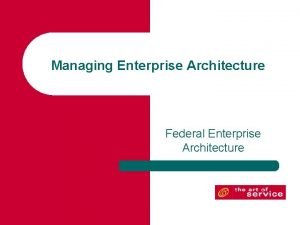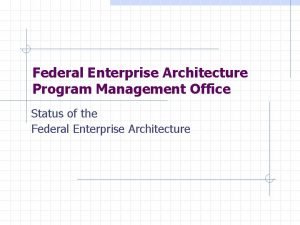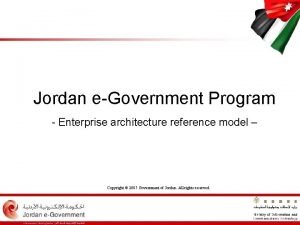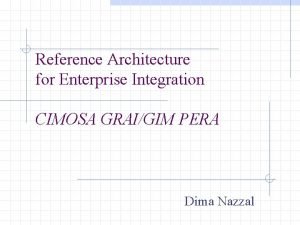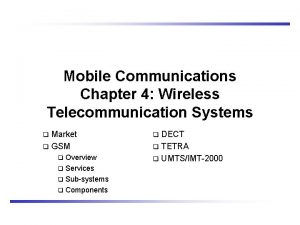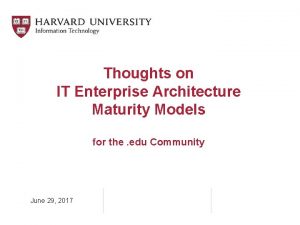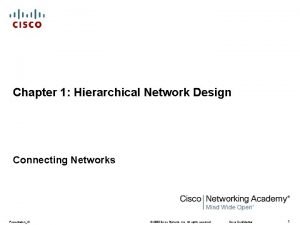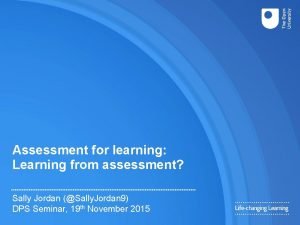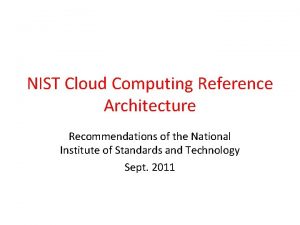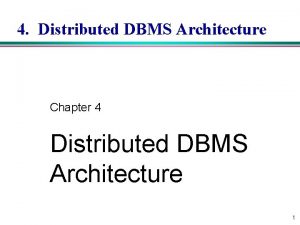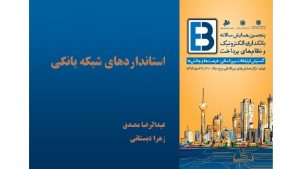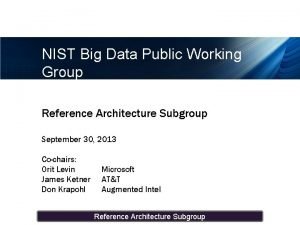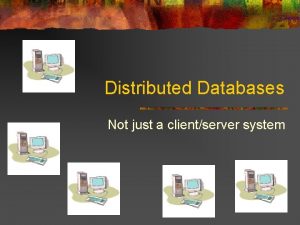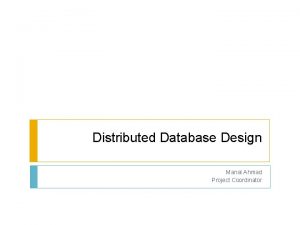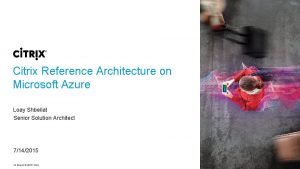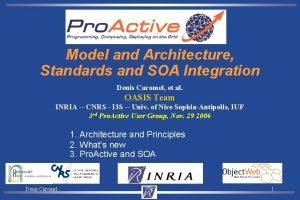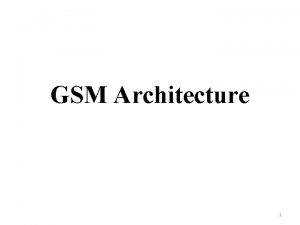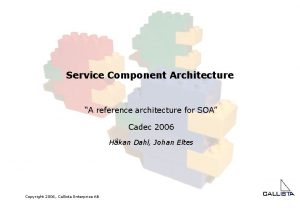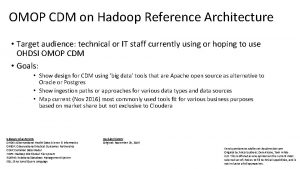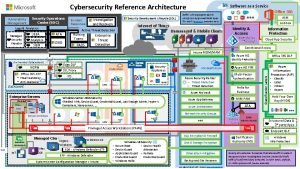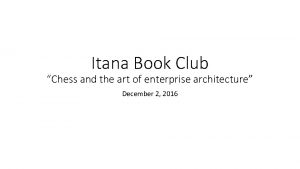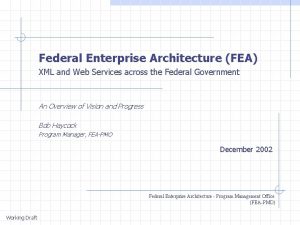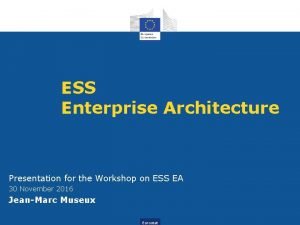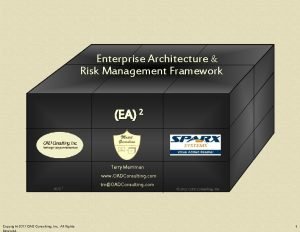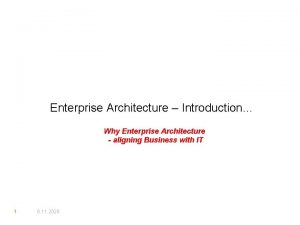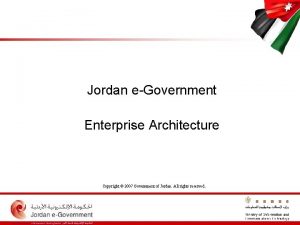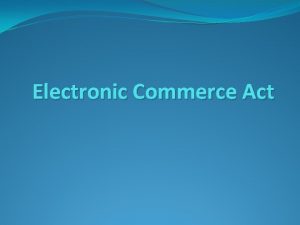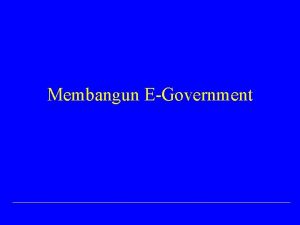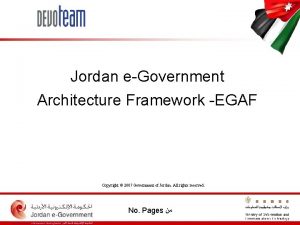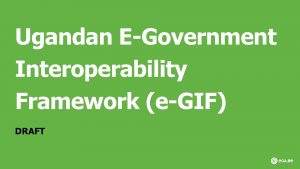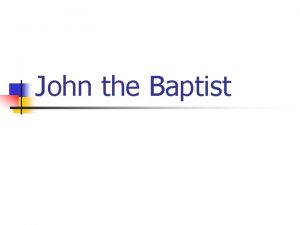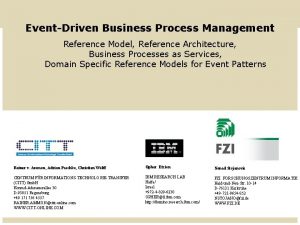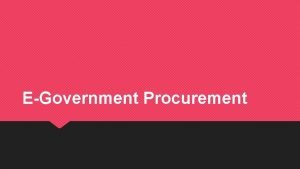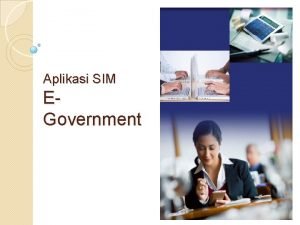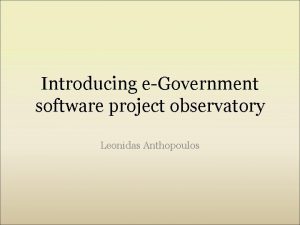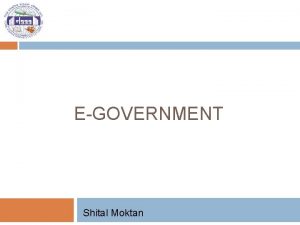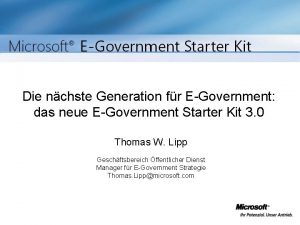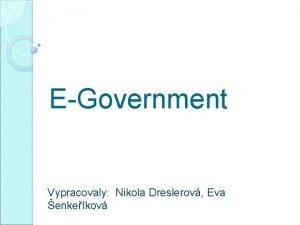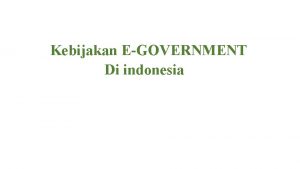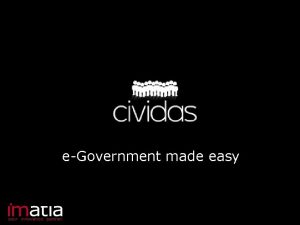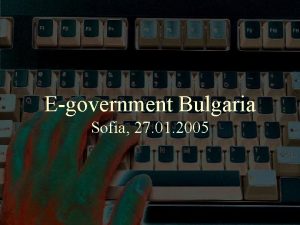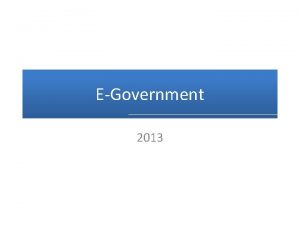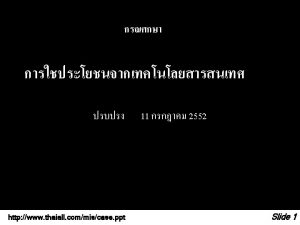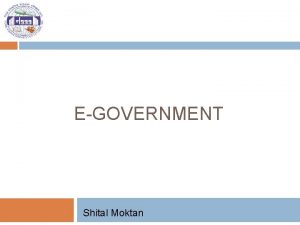Jordan eGovernment Program Enterprise architecture reference model Copyright
































- Slides: 32

Jordan e-Government Program - Enterprise architecture reference model – Copyright © 2007 Government of Jordan. All rights reserved.

Overview Introduction about e-Government Architecture • Framework (e-GAF) also referred to as Enterprise Architecture Reference Model Detailing the approach for developing an • enterprise architecture by government agencies based on the EA reference model. It includes – EA Process model – EA Framework 2

Introduction about e-Government Architecture Framework (e-GAF) also referred to as Enterprise Architecture Reference Model

Introduction The purpose of the reference architecture • model is to provide the government agencies with adequate reference material in order to: – Support government agencies that want to develop their enterprise architecture – Provide the entities with guidelines that allow them to hook up with the central architecture 4

About of the Reference Architecture Model The reference architecture represents the collective set of knowledge • relating to the e-Government architecture, technology standards, interoperability framework, and governance, and performance management. The reference architecture is presented in its entirety on the portal of • the government of Jordan. It is under the G 2 G section and available for authorized users The portal e-GAF section has two sections: • – The reference architecture material – An online discussion forum through which government agencies may pose questions and receive answers. Access to the reference architecture can be obtained through the e. Government of Jordan CIO office 5 •

Contents of Reference Architecture Model 1 Central architecture: Describes the e-Government central • platform architecture and specifications for the individual building blocks (e. g. ESB, Payment gateway, etc…) The Government agencies enterprise architecture • framework based on the FEAF framework. And it includes: – The customized FEAF framework including the templates with a defined procedure and guidelines on when and how to use them – Guidelines on how government agencies can architect against the central architecture above in order to utilize it. – Sample enterprise architecture based on an Mo. IT show case – A case study for building the EA based on the reference architecture model 6

Contents of Reference Architecture Model 2 Interoperability framework that describes the framework • for standardized data exchange between government agencies for cross government services. This covers: – The interoperability charter - GEFI – The interoperability blue prints covering the data standards, technical standards, and metadata standards. Technology standards and includes: • – SOA architecture principles standards – Software development standards Governance framework for the entire architecture • Technical Performance Model • Educational material • 7

This Document This document explains the framework how government • agencies develop their enterprise architecture framework based on the FEAF framework. – The customized FEAF framework including the templates with a defined procedure and guidelines on when and how to use them – Guidelines on how government agencies can architect against the central architecture above in order to utilize it. This document makes references to documents that are • part of the overall e-GAF and these documents can be found on the e-GAF online forum part of the Jordan Government Portal 8

Enterprise Architecture Reference Model

Process model overview This model is based on the Federal Enterprise Architecture Framework – FEAF – All references to e-GAF are presented in this color and in Italics Bold Obtain executive buy-in and support Maintain the enterprise architecture Use the enterprise architecture Establish management structure and control Control and Oversight Develop the sequencing plan Define an architecture process and approach Develop baseline enterprise architecture Develop target enterprise architecture

Notes about Process Model Not all steps in the process model are mandatory. • Government agencies may decide to work with a lighter model. It is advisable that the government agencies coordinate with the e-Government program CIO in order to agree on level of conformance The activities and bodies proposed in the • framework are captured in a roles martix attached with this document. See: 14. FEAF activity - role matrix 11

Obtain executive buy-in and support Define project proposal • Define architecture concept • Define high-level scope of work • Develop high-level plan for architecture project • Coordinate with Mo. ICT for e-GAF reuseability Project proposal Document business case • Identify benefits • Identify costs • Detail costs and benefits • Define qualitative benefits • Build financial model • Perform scenario- and sensitivity analysis • Document business case Business case Obtain executive support • Develop marketing material/presentation • Conduct meetings with executives to obtain buy-in Sales presentation Get project approval • Develop additional decision-support material • Submit documentation for approval Additional decision-support material

Establish management structure and control Set up project governance • Establish technical review committee • Establish capital investment council • Establish enterprise architecture steering committee • Establish program management office Project governance Set up project organisation • Define roles and responsibilities • Establish core team • Educate core team and key personell • Assign member to coordinate with Mo. ICT Project organisation Develop implementation plan • Identify core activities • Detail activities • Estimate resource requirements • Identify risk factors • Document implementation plan Initiate implementation • Identify and define project management practices . . . Environment . . . Project administration . . . Configuration and security management . . . Quality assurance Project management plan

Define architecture process and approach Define architecture framework Define architecture domain • Research enterprise architecture framework • Adjust enterprise architecture framework to defined purpose • Define intended use of architecture • Detail scope-of-work • Determine level of detail • Select perspectives • Select the standards from e-GAF that will be architected against Adjusted enterprise architecture framework Architecture domain Select notation and tools • Select notation for defined perspectives • Define tool selection criteria • Select enterprise architecture tool(s) Notation and tools Document architecture approach • Document architecture approach . . . Adjusted framework . . . Architecture domain . . . Notation . . . Tool evaluation reports Architecture approach

Develop baseline enterprise architecture Gather relevant information • Review available system documentation • Reverse engineer key applications, lacking updated documentation • Interview domain and system specialists Preliminary information Develop first draft baseline architecture Validate baseline architecture • Develop core component models • Develop architecture views • Perform impact analysis • Document first draft baseline architecture • Validate first draft baseline architecture with stakeholders • Prioritize feedback First draft baseline architecture Feedback from stakeholders Complete and deliver baseline architecture • Adjust baseline architecture • Perform internal and external quality assurance • Deliver baseline architecture Baseline architecture

Develop target enterprise architecture Gather information • Review vision and strategy documents • Identify technology trends • Interview domain and system specialists • Coordinate with Mo. ICT & liste-GAF components to use Preliminary information Define architecture vision • Define architecture vision, objectives, drivers, & constraints • Define principles • Complete and deliver architecture vision • Involve Mo. ICT architecture committee Architecture vision Develop target enterprise architecture Complete and deliver target architecture • Develop core components • Detail static and dynamic views • Perform impact analysis • Document target enterprise architecture • Validate with Mo. ICT • Validate target architecture • Adjust target architecture • Deliver target architecture First draft target enterprise architecture Target architecture

Develop sequencing plan Perform GAP analysis • Reconcile baseline architecture • Reconcile target architecture • Compare baseline and target architecture • Identify gaps List of work packages Develop migration plan • Define and differentiate legacy, migration and new systems • Prioritize list of work packages • Document migration plan Migration plan Develop first draft sequencing plan Complete and deliver sequencing plan • Develop high-level technology roadmap • Detail work packages • Consider relationships • Document sequencing plan • Validate sequencing plan with stakeholders • Perform internal (and external) quality assurance • Adjust sequencing plan • Deliver document Draft sequencing plan Sequencing plan

Use the enterprise architecture Integrate enterprise architecture Set up architecture governance • Integrate architecture process with budgeting and investment management • Integrate architecture process with ICT management • Establish enforcement processes & procedures • Define compliance criteria and consequences • Set up integrated reviews • Align with Mo. ICT e-GAF governance Integrated governance process Governance document Initiate projects • Prepare proposals • Align projects to enterprise architecture • Make investment decision • Execute projects • Evolve architecture with project Assess and evaluate enterprise architecture • Assess projects impact on enterprise architecture • Assess enterprise architecture • Evaluate results

Maintain the enterprise architecture Validate enterprise architecture • Ensure that the architecture reflect business operations • Ensure that the architecture reflect business objectives • Ensure that the architecture reflect system evolution Validate sequencing plan Validate architecture governance • Evaluate legacy system maintenance requirements against sequencing plan • Review, modify and validate sequencing plan • Control and oversee the architecture program • Ensure that necessary controls are in place and functioning Facilitate continuous improvement • Identify areas where enterprise architecture objectives are not being met • Take action to correct deviations

Framework overview Business Perspective Application Perspective Information Perspective Technology Perspective Conceptual Level Business model Service catalogue Information model Technology platform Logical Level Process model Application architecture model Logical data model Technical architecture model Operational Level Workflow model Application design model Physical data model Infrastructure model

Business model Description The business model describes the core and support activities an organization performs. Purpose The business model supports process and service orientation of e. Government activities Example model

Process model Description The process model describes processes within and between organisations. Purpose The process model supports processand service orientation, as well as business process improvement and re-engineering Example model

Workflow model Description The workflow model describes process and workflow on a detailed level. Validate for re-use of components from Mo. ICT Purpose The workflow model supports implementation of defined processes using selected technology. Example model

Service catalogue Description The service catalogue provides a highlevel overview of business services and e-services. Shared services to be reviewed from Mo. ICT e-GAF Purpose The service catalogue makes services visible and/or available to internal and external users. Example model

Application architecture Description The application architecture describes application components that supports business services and e-services. Validate against: 17. e-Services Central Platform Architecture Guidelines and SOA standards Purpose The application architecture provides a vehicle to connect and integrate services and technology Example model

Application design Description The application design describes implementation of applications. Validate against: 17. e-Services Central Platform Architecture Guidelines and SOA standards Purpose The application design supports implementation of specific applications and/or application integration. Example model

Information model Description The information model describes the core concepts related to a specific area or organisational unit. Purpose The information model provides a shared vocabulary for a specific area or organisational unit. Example model

Logical data model Description The logical data model provides a description of information elements and their relations. Validate against the Software Lifecycle Standards Purpose The logical data model provides a vehicle for creating a shared definition of a specified area or organisational unit. Example model

Physical data model Description The physical data model provides a detailed and technology-specific definition of data elements and their relations. Purpose The physical data model supports implementation of the data model, using a specific technology Example model

Technology platform model Description The technology platform model gives a high-level view of the technology platform, including all platform components. Validate against: 17. e-Services Central Platform Architecture Guidelines & GEFI standards Purpose The technology platform model provide the organisation with a highlevel understanding of the technology platform. Example model

Technical architecture model Description The technical architecture model describes the components and interactions between the components in the technology platform. Validate against: 17. e-Services Central Platform Architecture Guidelines Purpose The technical architecture models provide a detailed view of a certain area or organisational unit. Example model

Infrastructure model Description The infrastructure model details the technical components of the solution. Purpose The infrastucture model provides documentation as well as blueprints for ICT systems. Example model
 Federal enterprise architecture business reference model
Federal enterprise architecture business reference model Federal enterprise architecture program
Federal enterprise architecture program Enterprise architecture reference model
Enterprise architecture reference model Enterprise integration reference architecture
Enterprise integration reference architecture Pera model
Pera model Dect system architecture reference model
Dect system architecture reference model Cmm in software engineering
Cmm in software engineering Cisco enterprise architecture model
Cisco enterprise architecture model Reference node and non reference node
Reference node and non reference node Reference node and non reference node
Reference node and non reference node Putting the enterprise into the enterprise system
Putting the enterprise into the enterprise system Enterprise
Enterprise Sally jordan model
Sally jordan model Nist cloud security reference architecture
Nist cloud security reference architecture Reference architecture of distributed database
Reference architecture of distributed database Bian capability model
Bian capability model Nist big data reference architecture
Nist big data reference architecture Reference architecture of distributed database
Reference architecture of distributed database Reference architecture of distributed database
Reference architecture of distributed database Citrix on azure architecture
Citrix on azure architecture Soa reference architecture
Soa reference architecture Subsystem of gsm architecture
Subsystem of gsm architecture Soa roadmap
Soa roadmap Soa reference architecture
Soa reference architecture Method omop
Method omop Dell openstack reference architecture
Dell openstack reference architecture Security operations center microsoft reference architecture
Security operations center microsoft reference architecture Chess and the art of enterprise architecture
Chess and the art of enterprise architecture Fea enterprise architecture
Fea enterprise architecture E2af
E2af Enterprise architecture presentation
Enterprise architecture presentation Enterprise architecture risk management
Enterprise architecture risk management Enterprise architecture guiding principles
Enterprise architecture guiding principles
